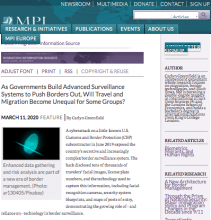As Governments Build Advanced Surveillance Systems to Push Borders Out, Will Travel and Migration Become Unequal for Some Groups?
A cyberattack on a little-known U.S. Customs and Border Protection (CBP) subcontractor in June 2019 exposed the country’s secretive and increasingly complex border surveillance system. The hack disclosed tens of thousands of travelers’ facial images, license plate numbers, and the technology used to capture this information, including facial-recognition cameras, security system blueprints, and maps of ports of entry, demonstrating the growing role of—and reliance on—technology in border surveillance.
The enlargement of border management systems is not only a phenomenon in the United States; governments worldwide are looking for faster, more precise ways to secure and manage legitimate travel and cargo through international borders. Global travel is increasing, with the International Air Transport Association expecting 7.2 billion passengers in 2035, nearly double the 3.8 billion passengers who traveled by air in 2016. Government authorities, therefore, have significant concerns about how to manage entry and exit at borders—both for short-term travelers and would-be immigrants. Yet the increasing sophistication of the resulting data systems, their powerful integration across databases, and the sharing of some information between agencies and even countries has happened almost entirely behind closed doors, without public debate.
Greenfield, C. (2020, March 11). As governments build advanced surveillance systems to push borders out, will travel and migration become unequal for some groups? Migration Policy Institute: https://www.migrationpolicy.org/article/governments-build-advanced-surveillance-systems

